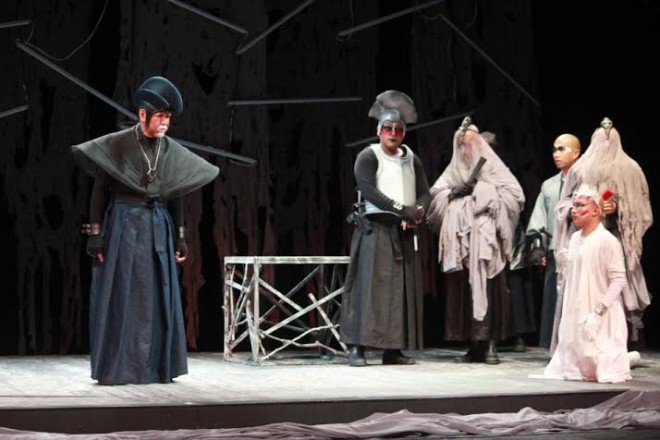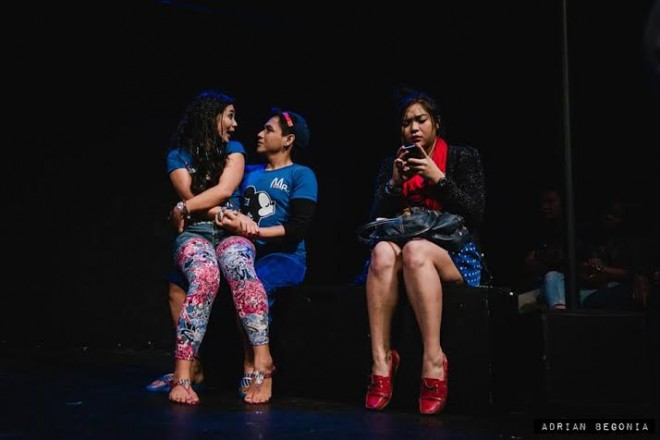Just scanning the official guide to Fringe Manila, which ran Feb. 12-Mar. 1, was enough to give us a headache. Eighteen days, 22 productions, 7 venues—it was as if the organizers were subtly daring us to kill ourselves for the love of theater.
The scheduling made it impossible to see everything, with most of the productions playing less than five performances, some even playing the same dates and time slots. Plus, it seemed almost all of Manila’s theater companies just had to open their shows for the first quarter of the year in February as well!
So we “theater-hopped” the best we could, always hoping that our perseverance might be rewarded with yet another genuinely pleasant surprise of a show or a marvelous breakout performance by some up-and-coming actor. Suffice to say, most times, we got what we were seeking for.

‘Haring Lear’
The return of the Philippine Educational Theater Association’s adaptation of “King Lear,” now “Haring Lear,” was certainly a welcome assault on the senses. The stage, designed by Gino Gonzales and lit by Jonjon Villareal, was transformed into a stark landscape of despair and decay—leafless branches, torn drapes, glaring fluorescent tubes. The all-male cast, their heads shorn, faces variedly colored, and garbed in flowing silhouette costumes in shades of black and white, spouted Shakespeare like devilish children gathered for a much-awaited funeral.
Bienvenido Lumbera provided a shimmering translation that rendered the anguish and tragedy inherent to the Bard’s prose more vividly. And none among the superlative cast directed by Nonon Padilla had a more masterful grasp of this language than Bernardo Bernardo, whose Lear was the blistering hurricane raging at the core of this howlingly innovative production.
‘Friction’
Lack of innovation, on the other hand, was what haunted “Friction,” a brand-new musical with music by Ejay Yatco and book by Bym Buhain and Miyo Sta. Maria.
For a musical about a writer grappling with his inner demons, it ironically featured depressingly uninspired and unoriginal writing, the dialogue irritatingly trite. The songs, while bearing Yatco’s tuneful flourishes, felt hardly vital to the story’s progress. Broadway devotees would have recognized the “Next to Normal” references, but the psycho-thriller elements in “Friction” never once thrilled, or inspired suspense, or made hairs stand on end, though director Toff de Venecia and his unquestionably talented actors—Red Concepcion, Gab Pangilinan and Myke Salomon—did what they could to keep it afloat.
‘Manhid: The Pinoy Superhero Musical’
Fantastical figures with tongue-twisting names landed on the CCP Main Theater for what was probably Fringe’s most widely publicized event: “Manhid,” the self-proclaimed Pinoy superhero musical, now resurrected by Ballet Philippines.
And two-and-a-half decades since its premiere, it was unfortunately more than just stale; the book by Kanakan Balintagos (the filmmaker Auraeus Solito), written as a protest piece against American neocolonialism and the apathy and ignorance supposedly hounding this nation, now came across as misguided, a case of not asking the right questions (a discussion that deserves a space of its own).
Worse, however, was the storytelling—or the excess of it. Jumping from setting to setting, scene to scene, with characters appearing left and right, lines and cues thrown here and there, none of them having ample time to settle, “Manhid” felt like watching an “X-Men” or “Avengers” movie, but with twice the number of characters let loose in an overgrown forest of a plot.
Thankfully, the music (by Carina Evangelista, Vincent de Jesus and The Eraserheads) found glorious life in the hands of Radioactive Sago Project as directed by Francis de Veyra. And Fred Lo (oozing with sex appeal as the many-faced Radia), KL Dizon (enchanting as the insect goddess Urduja) and Kim Molina (the potty-mouthed, hotheaded Allunsina) provided three of this quarter’s strongest musical theater performances.
‘The Pillowman’
The Sandbox Collective’s devised reading of Martin McDonagh’s “The Pillowman,” about a fictionist’s brutal inquisition by a pair of policemen, inadvertently illustrated that “if it ain’t broke, don’t fix it.”
Ed Lacson Jr. had mounted an astounding staged reading of this play last year. This time, pushing the idea way into the tricky realm of meta, he staged this version as an actual interrogation, with just three screens showing “live footage” of the entire play (behind the wall, the actors performed in a triangular sliver of space, captured by a pair of cameras).
It felt like watching CCTV footage alright: It was distant, dragging and ultimately tiring. The palpable horror, the twisted humor and sense of the macabre that made last year’s “Pillowman” such an emotional and sensationally acted production—“the year’s most entrancing piece of theater,” we wrote—were all lost, blunted by the newly installed technological barriers (and we haven’t even mentioned how awkward the blocking translated onscreen).
Even Richard Cunanan, still landing those zingers as self-appointed good cop Tupolski, couldn’t salvage this show. (Art Acuña was a proper fit as temperamental bad cop Ariel.) As for the new leads—Bong Cabrera as the writer Katurian and Jojo Cayabyab as his mentally impaired brother—well, let’s just say those roles were already in perfect hands with Audie Gemora and Robie Zialcita last year.
‘Tungkol kay Angela’
“Tungkol kay Angela,” Joshua Lim So’s Palanca-winning play about a couple who encounter a young man named Fred, was an intimately powerful experience, benefiting from Banaue Miclat’s restrained direction and perceptive dissection of the text. Understatement and the unspoken hovered thickly over Io Balanon’s approximation of the couple’s cramped apartment, which persuasively conjured the claustrophobia of the play’s martial-law setting.
Mailes Kanapi and Roeder Camañag were their usual brilliant selves as the nameless couple, but this show was really about Vincent Kevin Pajara’s fierce breakout turn as Fred, in a portrayal that at once displayed youth’s fragility and unstoppable vitality, and remarkably more than stood its own alongside those of the veteran performers.

‘Kwentong Komyut’
“Kwentong Komyut,” consisting of five short plays all directed by Jethro Tenorio, was a literal joyride that reveled in fleshing out the minutiae and subtle ironies of middle-class life in Manila, using the various modes of public transport as its platform.
Tyron Casumpang’s “Si Aling Coring” featured the talkative, borderline-intrusive lola (a wonderful Virlynn Ramirez) who unfortunately had to be your seatmate on the longest plane ride ever. Victor Robinson and Rissey Reyes’ “#Halaga” had the peculiar denizens of the jeepney world—the chicharon vendor, the fare collector, the beggar—all essayed rambunctiously by a shape-shifting Karlo Erfe.
The best of the lot was Dolly Dulu’s “Pasensya Na, Bakla Lang.” This showcase of sharp, elegant dialogue offered a hilarious, moving portrait of love past, lost and lingering, as seen through the eyes of a gay ex-couple—terrifically and touchingly played by Lei Ramos and Kalil Almonte—trying to hail a taxi on their way to a Halloween party.

‘Maniacal’
If any production from Fringe deserves a second, longer life, it’s “Maniacal,” the backstage drama written and directed by George de Jesus. With a sterling cast that lent their stereotypical characters much-needed vibrancy —among them, Mayen Cadd as the mercurial diva, Red Concepcion as the egotistical film actor, and especially Via Antonio as the splitting, tumbling, pirouetting bitter-actress figure—this take on a fascinating but worn-out subject was marked by an unexpected freshness and unforgiving truthfulness.
The explosive dialogue, littered with tongue-in-cheek references to all things Philippine theater and sparing no local company in the process, hit quite close to home. That the satire came packed with so much heart, utilizing the idiosyncrasies of this booming theater scene to transform itself into an endearing tribute to a complicated industry, was its tender, welcome surprise.
Visit the author at www.vincengregorii.blogspot.com, follow on Twitter twitter.com/vincengyu.












































